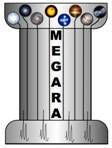Dept. Astrofísica y CC de la Atmósfera Univ. Complutense de Madrid
| Research lines:
Local star-forming galaxies Galaxy models Surveys Databases SHARDS project Stellar libraries Early-type galaxies Meteors and Fireballs Dark Skies |
Instrumental developments: MEGARA:Multi-Espectrógrafo en GTC de Alta Resolución para Astronomía |  |
| EMIR: Espectrógrafo Multiobjeto en el InfraRrojo |

| |
| FRIDA: inFrared Imager and Dissector for Adaptative optics |
 |
Sos del Rey Católico: IV Scientific meeting of the GTC-Consolider
In november 10th to 12th, the IV Scientific meeting of the GTC-Consolider project was held in Sos del Rey Católico. 
The "UCM-Galaxies" group contributed with 8 out of 31 talks.
The UCM delegation was one of the best represented groups, with two members of the executive committee, one invited talk and an active role both during the scientific sessions and the post-meeting evenings.
Participation in ADASS'10
The Astronomical Data Analysis Software and Systems (ADASS) conference has been held this year in Boston. GUAIX has been represented in this conference with the participation of Nicolás Cardiel and Sergio Pascual.
Two posters were presented. Cardiel's poster Using boundary fits to determine spectra pseudo-continua describes a new approach to compute the pseudo-continuum using boundary fits and the boundfit program.
Pascual presented the current status of the EMIR pipeline in PyEmir: Data Reduction Pipeline for EMIR, the GTC Near-IR Multi-Object Spectrograph.
Press releases about MEGARA
Some articles about MEGARA (Multi-Espectrógrafo en GTC de Alta Resolución para Astronomía) have recently appeared in different media:
UCM: MEGARA, futuro instrumento óptico para el telescopio GTC
madri+d: MEGARA, futuro instrumento óptico para el Gran Telescopio de Canarias
IAC: Gran Telescopio CANARIAS: Tercera generación de instrumentos en marcha
ABC: El GTC incorporará instrumentos para estudiar cúmulos estelares
MEGARA, futuro instrumento óptico para el Gran Telescopio de Canarias
Astrofísicos de la Universidad Complutense de Madrid (UCM) lideran el desarrollo del que será el próximo instrumento óptico del Gran Telescopio Canarias: el Espectrógrafo MEGARA. El pasado día 30 de septiembre el comité responsable del Gran Telescopio Canarias (GTC), que cuenta con un espejo primario de más de 10 metros de diámetro y es el telescopio óptico-infrarrojo más grande del mundo, anunció la elección del espectrógrafo MEGARA para la siguiente fase de diseño y, una vez completada la fase de diseño satisfactoriamente, futura construcción del próximo instrumento óptico para GTC.
Proyecto NIXNOX. Llegan los fotómetros SQM
Las primeras 12 unidades del Sky Quality Meter (SQM-L) que han sido adquiridas por la Sociedad Española de Astronomía (SEA) han sido enviadas por la empresa Unihedron y se encuentran en el laboratorio óptico del Departamento de Astrofísica y CC. de la Atmósfera de la Universidad Complutense de Madrid (LICA-GUAIX) a la espera de ser calibradas.
Estos fotómetros serán utilizados por los astrónomos aficionados de toda España para obtener datos del proyecto NIXNOX.













